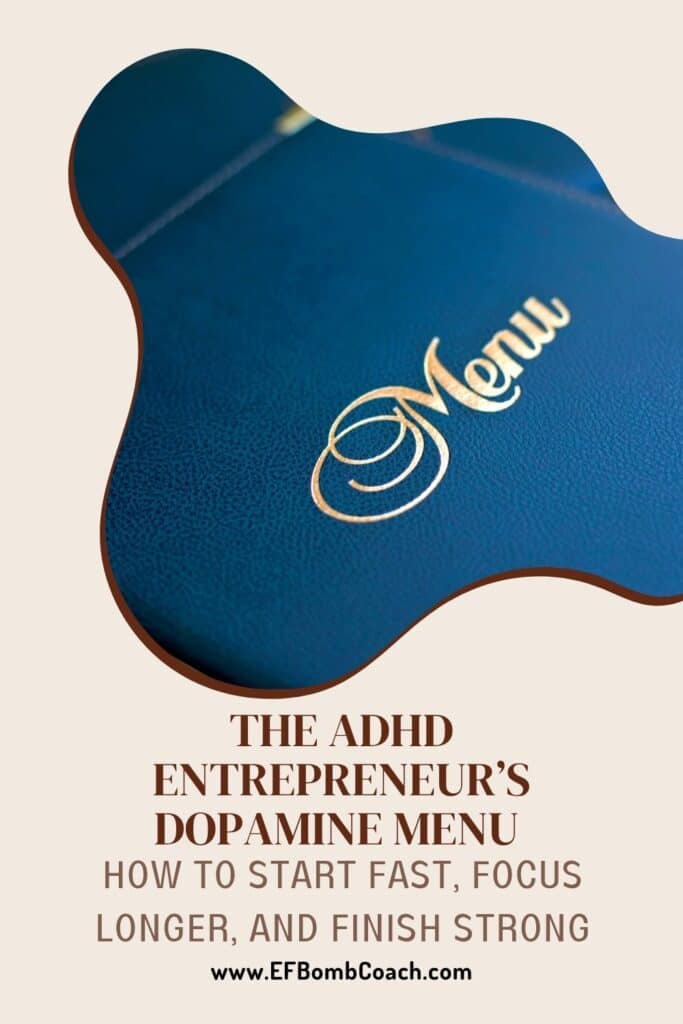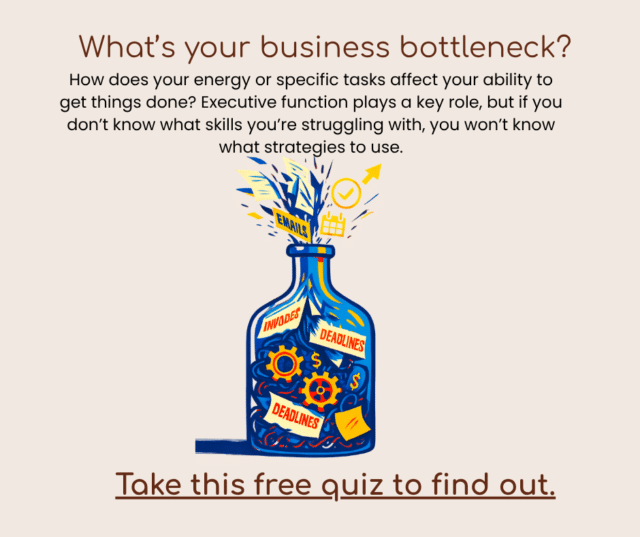The ADHD Entrepreneur’s Dopamine Menu (How to Start Fast, Focus Longer, and Finish Strong)
It’s 2 p.m. You’ve stared at the same proposal for 45 minutes, checked your email six times, reorganized your desk twice, and now you’re convinced your coffee maker needs a deep clean. Does your day ever go like that?
If you run a business with ADHD, you don’t have a motivation problem, you have a fuel problem. Your brain runs on a different system. When you feed it the right inputs, you get traction. When you don’t, you spin. A simple tool, a dopamine menu, helps you choose what your brain needs so you can start, sustain focus, and actually finish.
Why Your ADHD Brain Needs a Different Approach to Productivity
Here’s the truth a lot of productivity advice misses. ADHD brains often have a lower baseline of dopamine. That makes “just focus” advice feel like driving with the tank on fumes. You push, you white-knuckle it, you try to power through, and you still stall out. That’s not laziness or lack of discipline. It’s neurochemistry.
You’ve probably tried all the classics. Pomodoro timers, color-coded planners, yet another app with yet another notification. Some of it helps for a bit. Then the wheels come off. The problem isn’t you. The problem is trying to use a system designed for a different brain. You need a simple way to feed your brain what it needs, when it needs it, so work feels doable, not heavy.
- ADHD brains crave engaging tasks that deliver quick dopamine hits.
- Without a plan, you start with big goals, bounce between 47 tabs, then research the history of typewriters at 11 a.m. because it felt interesting.
- Shame spirals follow. That shame steals even more focus.
- The fix: build a strategic toolkit that feeds your brain, instead of fighting it.
A dopamine menu gives you options you can grab fast, matched to what your brain needs in the moment.

What Is a Dopamine Menu?
Think of a restaurant menu. Appetizers, entrees, sides, desserts. A dopamine menu uses the same structure, except you’re listing activities that give your brain dopamine hits and help you move your business forward. It’s not a to-do list. It’s a choose-what-works-now list.
Why it works: your brain needs interest, challenge, or novelty to engage. The menu gives you pre-chosen ways to spark that engagement without burning yourself out trying to power through.
Your menu has five parts:
- Appetizers: quick wins that create momentum.
- Entrees: the main business movers with clear outcomes.
- Sides: necessary support tasks that need a little help.
- Desserts: joy breaks that reset your brain.
- Specials: options matched to your brain state that day.
Grab a notebook or a notes app. Build as you read.
Building Your Dopamine Menu: Step-by-Step Guide
Entrees: Your Main Dopamine Drivers
Entrees are your core business tasks that feel engaging, offer clear outcomes, and give you a solid dopamine bump. They move your business forward and make you think, “I can do this.”
Your list won’t look like anyone else’s. That’s the point. Don't copy a template and call it a day. If writing content drains you, it doesn’t belong here. If collaboration lights you up, it might be your best entree.
Common entree examples:
- Creating content you’re passionate about. Recording a video, writing a blog post, or designing a graphic. The instant feedback of creating and publishing is often ADHD gold.
- Client calls or collaborations. The interaction, energy exchange, and problem solving can be deeply stimulating.
- Designing visual elements. If you’re a visual thinker, this can be immersive and satisfying because you see progress right away.
- Writing copy or emails when you’re in it. Not forced writing. The “I’ve got this” feeling that helps you move fast.
- Brainstorming new ideas or strategies. Idea generation is a strength. Use it to outline launches, map offers, or solve client problems.
Action: Jot down 3 to 5 business tasks you actually like. The ones that make you look up and say, “Oh dang, where did those two hours go?” Those are your entrees. Keep them short and concrete, like “record a 3-minute tip video,” “outline a client workshop,” or “mock up a landing page.” If there are a few that are your go-to favorites, mark them as priority entrees.
Sides: The Necessary But Less Exciting Supports
Side dishes are the tasks you need to run your business, even if they don’t light your brain on fire. They become easier if you pair them with an entree or batch them when your energy is medium. Listen to music, set a short timer, and get in and out.
Side examples:
- Routine emails, like invoices or scheduling notes.
- Scheduling social posts.
- Light admin, such as updating your CRM, organizing files, bookkeeping, or following up on leads.
- Editing content you’ve already created.
Two simple ways to use sides:
- Pair them with entrees. Do three routine emails, then reward yourself with a favorite entree, like a client call or quick video.
- Batch on a medium-energy afternoon with a playlist you love. You’ll go further when you expect less excitement from the task.
Action: List the side tasks you tend to push off, but must do. Then mark the ones you’ll batch weekly.

Appetizers: Quick Wins for Momentum
Appetizers are 5 to 10 minute tasks that prime your brain. They give you tiny wins and a quick dopamine boost so you can start. They are not distractions. They are purposeful starters that make it easier to move into an entree.
Appetizer ideas:
- Respond to one easy DM or comment. Short and kind. “Thanks for watching!”
- Update your “done list.” At the end of a work block or day, write what you finished to train your brain to notice wins.
- Organize one desktop folder. Not your whole drive. Just one.
- Post a quick story or authentic update.
- Check off a small admin task, like archiving old emails or updating a link.
- Read one positive testimonial from your “wins folder.” Save screenshots of kind words so you can grab a boost when dopamine is low.
Action: Write 5 to 7 appetizers you can do fast when you start your day. Number them so you can pick one without thinking: 1) one DM, 2) done list, 3) one folder, 4) one story, 5) archive 20 emails, 6) read one win, 7) update a link.
Desserts: Pure Joy for a Brain Reset
Desserts are for joy. They are not disguised work. They are planned, short, and refreshing, and they help your brain come back online. Using desserts is not procrastination when you plan them on purpose. They are fuel for focus.
Dessert ideas:
- A 5-minute dance party to your hype playlist. Movement plus music is powerful.
- A short walk around the block. Sun on your face, air in your lungs, reset your nervous system.
- Scroll something fun, not your business feed. Cat videos count. Doom scrolling does not.
- Text a friend a funny thing you saw. Real connection gives you a bump.
- Play with your pet.
- Make your favorite snack or drink. The ritual helps as much as the taste.
- Five minutes on a hobby you miss. Guitar, doodling, crocheting a single row.
Action: Add 5 to 7 items that are pure joy. Give yourself permission. Your brain works better when you feel human, not just productive.
Specials: Tailored to Your Brain States
Specials are advanced. They match what you do to how your brain feels right now. You won’t nail this on day one. Start simple, track what works, then refine. Over time you’ll see patterns and know which option to grab.
Here’s a simple way to think about it:
| Brain State | What To Do |
|---|---|
| Overstimulated | Noise-canceling headphones, dim lights, one simple task, no multitasking |
| Understimulated | Upbeat music, a fidget tool, choose a more challenging task |
| Anxious | Calm your body first, breathe, short walk, then a low-pressure appetizer |
| Hyperfocused | Go all in, set timers to eat, drink water, and take breaks |
| No motivation | Do one appetizer, one dessert, then 10 minutes on one entree |
Action: pick 3 to 5 specials you can try this week. Add one note about what worked after you use each one. Adjust next week.
If you want a broader perspective on how people are using dopamine menus for productivity, this Fast Company piece shares a simple approach to a TikTok-inspired dopamine menu. Use it for extra ideas, then tailor your list to your business.

How to Use Your Dopamine Menu in Real Life
Momentum Builder Strategy
Start sessions with a quick win. Then ride that energy into deeper work, reset as needed, and finish with something lighter.
- Appetizer for 5 minutes.
Example: respond to one DM, draft a client proposal, take a 5-minute walk, then schedule next week’s posts.
Energy Match Strategy
Match tasks to your natural energy instead of fighting it.
- High energy mornings: entrees.
- Afternoon slump: sides and a few appetizers.
- Evenings: desserts and light admin.
- On low days: shorter blocks and more planned desserts.
You’ll get more done with less friction when you stop forcing the wrong task at the wrong time.
Motivation Rescue Strategy
When you can’t start, reduce the goal. Do one appetizer, one dessert, then try an entree for just 10 minutes. It’s about initiation, not completion. Once you begin, momentum usually shows up. If it doesn’t, reset and repeat the cycle with a different entree.
Pre-Task Primer Strategy
Before a hard task, ask, “What does my brain need right now to do this?” Pick from your menu. Maybe you need a dessert to settle anxiety. Maybe an appetizer to prime momentum. Maybe a side paired with the entree to make it feel lighter. You have options. Use them.

Did you know I have a membership for women who want to improve their executive function skills? Check it out here.
Common Mistakes to Avoid with Your Menu
Keep your menu short, clear, and alive. The goal is to use it, not admire it.
- Too complicated. Fifty items per category will overwhelm you. Fix: limit each section to 5 to 7 items. Swap as your business changes.
- Only productive activities. If all your desserts are work in disguise, you’ll burn out. Fix: include true joy. “Research competitors” is not dessert.
- Ignoring specials. Your brain state often matters more than your task list. Fix: adjust for overstimulation or anxiety before you demand complex work.
- Never updating the menu. What worked last season might not work now. Fix: refresh seasonally. Keep what works, drop what doesn’t.
- Self-judgment. “Why can’t I just…?” is a trap. Fix: your brain is different. This menu is an adaptation that helps you perform and feel better.
Your menu isn’t about turning you into a machine. It’s about understanding how your brain works so you can support it and get meaningful work done without the shame spiral.
Putting It All Together
Build your menu in one sitting, then use it daily for a week. Keep it visible. Start sessions with an appetizer. Match tasks to your energy. Treat desserts as strategic, not guilty pleasures. Note what works and what falls flat. Adjust next week. You’ll see more starts, better focus, and more finished work.
If this speaks to you, try it today. Write three entrees, three sides, three appetizers, three desserts, and one special. That’s your starter menu. You can expand later.
You don’t have a discipline problem, you have a planning problem. A simple, tailored dopamine menu gives you fast choices that match how your brain actually works. Start small, keep it simple, and update as you learn your patterns. What goes on your menu this week?








